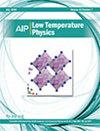Evolution of the pseudogap temperature dependence in YBa2Cu3O7–δ films under the influence of a magnetic field
IF 0.8
4区 物理与天体物理
Q4 PHYSICS, APPLIED
引用次数: 0
Abstract
The evolution of the temperature dependence of the pseudogap Δ*(T) in optimally doped (OD) YBa2Cu3O7–δ (YBCO) films with the superconducting critical temperature Tc = 88.7 K under the influence of a magnetic field B has been studied in detail. It has been established that the shape of Δ*(T) for various B over the entire range from the pseudogap opening temperature T* to T01, below which superconducting fluctuations occur, has a wide maximum at the BEC-BCS crossover temperature Tpair, which is typical for OD films and untwinned YBCO single crystals. T* was shown to be independent on B, whereas Tpair shifts to the low-temperature region along with the increase in B, while the maximum value of Δ*(Tpair) remains practically constant regardless of B. It was revealed that as the field increases, the low-temperature maximum near the 3D-2D transition temperature T0 is blurred and disappears at B > 5 T. Moreover, above the Ginzburg temperature TG, which limits superconducting fluctuations from below, for B > 0.5 T, a minimum appears on Δ*(T) at Tmin, which becomes very pronounced with a further increase in B. As a result, the overall value of Δ*(T) decreases noticeably most likely due to the pair-breaking effect. A comparison of Δ*(T) near Tc with the Peters–Bauer theory shows that the density of fluctuating Cooper pairs actually decreases from ⟨n↑n↓⟩ ≈ 0.31 at B = 0 to ⟨n↑n↓⟩ ≈ 0.28 in the field of 8 T. The observed behavior of Δ*(T) around Tmin is assumed to be due to the influence of a two-dimensional vortex lattice created by the magnetic field, which prevents the formation of fluctuating Cooper pairs near Tc.磁场影响下 YBa2Cu3O7-δ 薄膜的伪间隙温度依赖性演变
我们详细研究了在磁场 B 的影响下,具有超导临界温度 Tc = 88.7 K 的最佳掺杂 (OD) YBa2Cu3O7-δ (YBCO) 薄膜中伪隙 Δ*(T) 的温度依赖性演变。研究发现,从伪隙打开温度 T* 到 T01(超导波动发生在 T01 以下)的整个范围内,不同 B 的 Δ*(T)形状在 BEC-BCS 交叉温度 Tpair 处有一个宽的最大值,这是 OD 薄膜和未捻合 YBCO 单晶的典型特征。研究表明,T* 与 B 无关,而 Tpair 则随着 B 的增大而转移到低温区域,而 Δ*(Tpair)的最大值实际上保持不变,与 B 无关。研究表明,随着磁场的增大,三维-二维转变温度 T0 附近的低温最大值变得模糊,并在 B > 5 T 时消失。此外,在 B > 0.5 T 时,在金兹堡温度 TG(从下到上限制超导波动)之上,Δ*(T) 在 Tmin 处出现一个最小值,随着 B 的进一步增大,这个最小值变得非常明显。将 Tc 附近的 Δ*(T) 与彼得斯-鲍尔理论进行比较后发现,波动库珀对的密度实际上从 B = 0 时的➎n↑n↓⟩≈0.31 下降到 8 T 磁场中的➎n↑n↓⟩≈0.28。在 Tmin 附近观察到的Δ*(T)行为,假定是由于磁场产生的二维涡晶格的影响,它阻止了波动库珀对在 Tc 附近的形成。
本文章由计算机程序翻译,如有差异,请以英文原文为准。
求助全文
约1分钟内获得全文
求助全文
来源期刊

Low Temperature Physics
物理-物理:应用
CiteScore
1.20
自引率
25.00%
发文量
138
审稿时长
3 months
期刊介绍:
Guided by an international editorial board, Low Temperature Physics (LTP) communicates the results of important experimental and theoretical studies conducted at low temperatures. LTP offers key work in such areas as superconductivity, magnetism, lattice dynamics, quantum liquids and crystals, cryocrystals, low-dimensional and disordered systems, electronic properties of normal metals and alloys, and critical phenomena. The journal publishes original articles on new experimental and theoretical results as well as review articles, brief communications, memoirs, and biographies.
Low Temperature Physics, a translation of the copyrighted Journal FIZIKA NIZKIKH TEMPERATUR, is a monthly journal containing English reports of current research in the field of the low temperature physics. The translation began with the 1975 issues. One volume is published annually beginning with the January issues.
 求助内容:
求助内容: 应助结果提醒方式:
应助结果提醒方式:


